Attending were Mr. Nguyen Van Loi - Member of the Party Central Committee, Secretary of the Provincial Party Committee, Head of the Provincial Delegation of National Assembly Deputies, Head of the Steering Committee for Provincial Planning; Mr. Vo Van Minh - Deputy Secretary of the Provincial Party Committee, Chairman of the Provincial People's Committee (PPC); Mr. Nguyen Van Hung – BOD Chairman of Becamex IDC Corp, member of the Steering Committee for Provincial Planning; and members of the Steering Committee, the Supporting Group of the Steering Committee for provincial planning; leaders of departments, committees, branches, districts, towns and cities; consulting unit for provincial planning.
Remove "bottlenecks" that hinder development
At the Seminar, the consulting unit reported: Orientation of integrated strategic framework for Binh Duong province's planning; development orientation of important industries and fields; orientation of spatial development planning and infrastructure system.
The basis of this integrated strategy is the advantageous location and regional linkage so that Binh Duong becomes the first high-income province of Vietnam by 2030, the hub of international trade and the center of the Southeast region. The report at the beginning of the term clearly pointed out the special location of Binh Duong province - playing the role of an important transit location between the Central Highlands, the Southeast, the Southwest and Ho Chi Minh City, an important link of the Southeast economic corridor. Binh Duong plays the role of the northern rear of Ho Chi Minh City, also the rear with the largest natural resources due to its connection with the Central Highlands, Southern Laos and Eastern Cambodia.
Resolution No. 24-NQ/TW dated October 07, 2022 of the Politburo on socio-economic development and assurance of national defense and security in the Southeast region to 2030, with a vision to 2045, clearly identifies Binh Duong province as belonging to two economic sub-regions in the North and the Center. In which, the northern sub-region including Tay Ninh and Binh Phuoc provinces and the northern region of Dong Nai and Binh Duong provinces is a development zone of border gate economy, logistics, expanding the industrial development space of the region; the central sub-region including Ho Chi Minh City, the southern region of Binh Duong province and the southwest of Dong Nai province is the development center of the whole region, outstanding with strengths in high-tech and specialized industries, high quality services, education - training, healthcare and international trade hub.
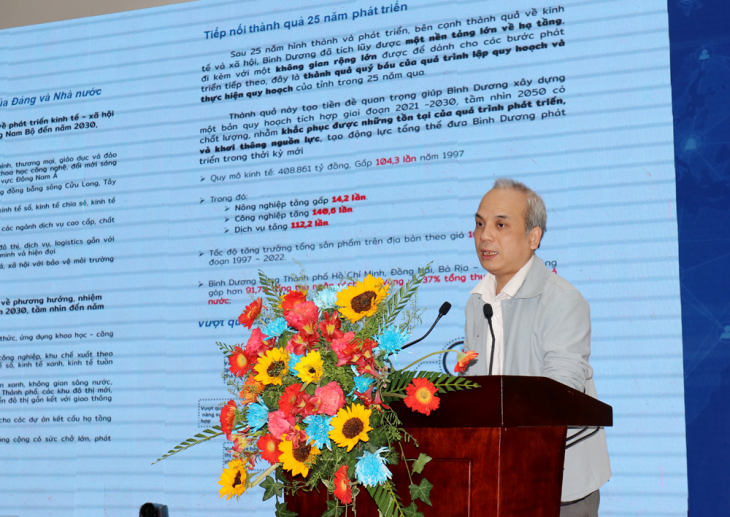
MSc.Architect Nguyen Xuan Anh - Representative of VIUP brief reports on Binh Duong province planning for the 2021-2030 period, with a vision to 2045
Through more than 25 years of development, Binh Duong has accumulated a great foundation of infrastructure, which is a valuable result of the provincial planning process and planning implementation. However, according to Assoc.Prof.Dr.Architect Hoang Vinh Hung - Deputy Director of VIUP, Binh Duong is facing a number of bottlenecks and challenges that need to be solved in order to free up resources and create an overall impetus for Binh Duong to continue developing in the new period. Specifically, regional connections are congested; especially the transport infrastructure connecting the Southern part of the province is overloaded. The economic growth model faces many challenges such as middle income trap, low proportion of service economy structure, lack of high quality human resources; production is labor and land intensive. Along with that are the challenges of spatial model and infrastructure development without a long-term vision; values of cultural and ecological resources are being forgotten and services are limited; the social environment has many potential risks; competition in the region and in the country is becoming more and more fierce, international fluctuations are unpredictable, etc.
The planning targets that by 2030, Binh Duong will develop according to the model of a centrally run city, which is an important growth pole of the Southern key economic region and the whole country. Binh Duong pioneers in transforming the development model towards modern industries and high-quality services based on the core of a complete innovation ecosystem. The average economic growth rate in the 2021-2030 period reaches about 10%/year; GRDP per capita is about 15,700 USD (412 million VND); the proportion of digital economy reaches 30% of GRDP. Economic growth in the 2031-2050 period is about 5.5 - 6%/year; GRDP per capita is about 31,300 USD, making it a province with a high middle income level; the proportion of processing and manufacturing industry reaches 50% of GRDP.
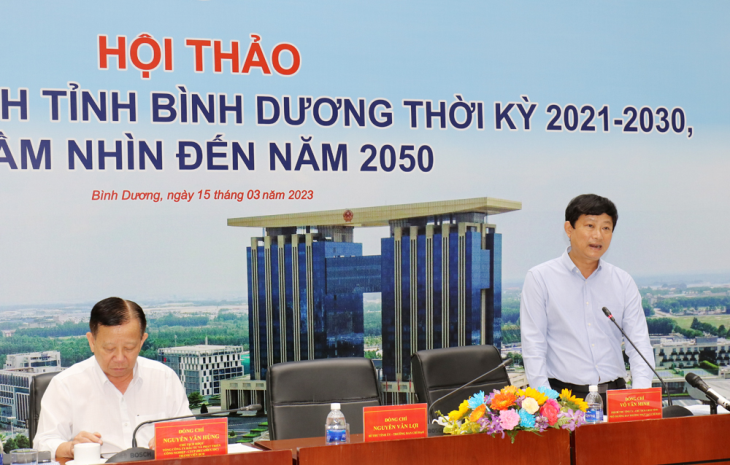
The PPC Chairman Vo Van Minh speaks at the Seminar
Discussion at the Seminar showed that, to achieve the set goals and overcome the "middle income trap" is not only an economic problem but also a test of local governance capacity. According to MSc.Architect Nguyen Xuan Anh - VIU, in order for Binh Duong to become a center and focal point based on regional linkage and open development, the province needs to continue to combine with national programs and cooperate with neighboring localities to promote the completion of connections by road, rail and river with the center of Ho Chi Minh City. The province also continues to develop according to the model of innovation based on expanding the development space of existing industrial parks and urban areas, applying science and technology to production, management, social services, contributing to creating a new type of ecosystem for socio-economic development of the province. In which, 06 pillars to promote the province's development in the coming period include: Inheritance development, innovation-based development, specialized coordinated development, sustainability-based development, open multilateral development, and common development covering all social classes.
At the seminar, representatives of departments, committees, branches and localities also commented on the content related to the planning of each specific sector and field.
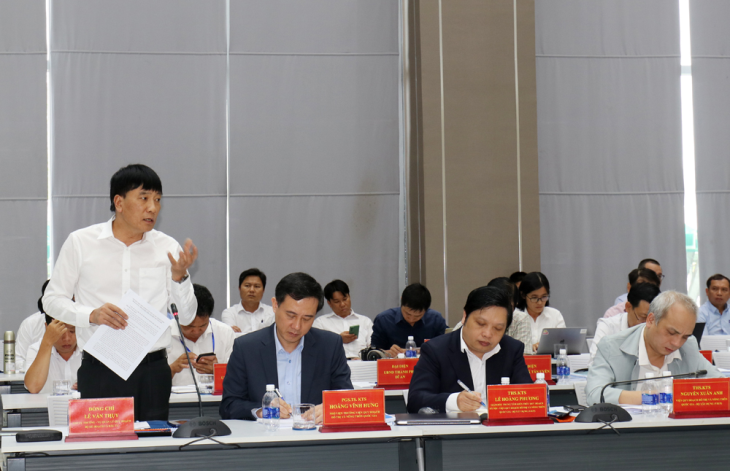
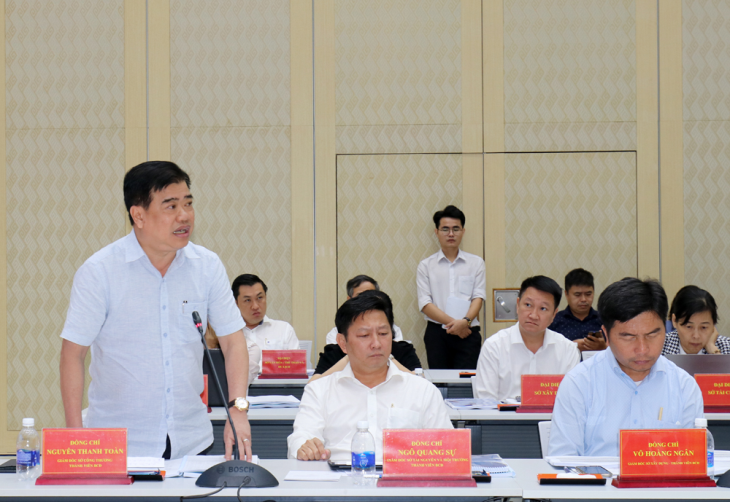
Representatives of departments, branches and units comment at the Seminar
Motivation for a new development period
The Planning Law 2017 has set higher requirements in the integration of goals and interdisciplinary approaches in provincial planning on the same development territory in regional linkages. The integration requires coordination between branches, levels and stakeholders towards solving immediate and long-term problems, ensuring the provincial planning has a long-term vision.
Binh Duong identifies the importance and role of provincial planning, as a guideline for the new development period and beyond, aiming to develop a breakthrough into a high-income province based on 03 philosophies: Building an effective business and investment environment; harmonious, humane and sustainable society; dynamic and constructive local government. Provincial planning for the 2021-2030 period, with a vision to 2050 will be an extremely important tool for the province to orient, operate and manage in order to continue to develop rapidly and sustainably.
Speaking at the Seminar, Secretary of the Provincial Party Committee Nguyen Van Loi assessed that this draft has a step closer to improving the content and depth of the Planning's requirements, especially having absorbed quite good comments at the beginning Seminar. The connotation of each content of the draft Planning has basically followed the development requirements of the province and Resolution No. 24 of the Politburo.
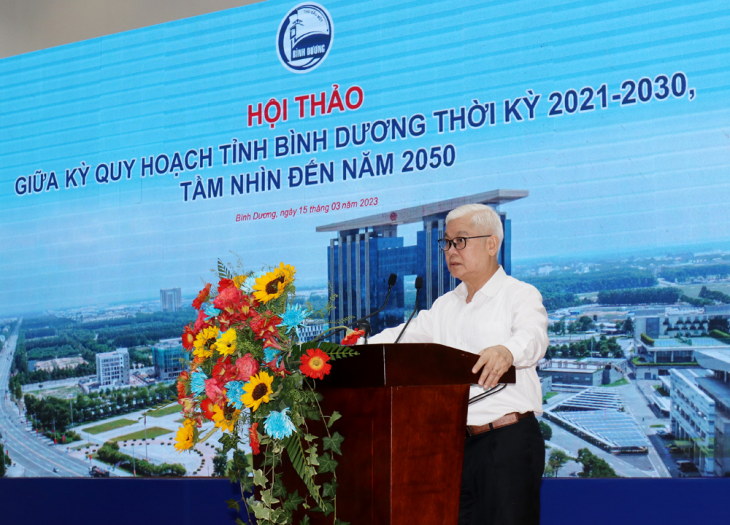
Secretary of the Provincial Party Committee Nguyen Van Loi speaks at the Seminar
The Secretary emphasized a number of key contents for experts, scientists, departments and branches to continue researching and perfecting the planning scheme to submit to the final-term Seminar, in which it is necessary to closely follow Resolution No. 24 and potential conditions and competitive advantages of Binh Duong to set out the most optimal, appropriate and feasible development scenario.
Specifically, on the orientation of Binh Duong's development space, studying the development space into regions: The southern area, including Thuan An, Di An, and Tan Uyen, is the gateway center of Binh Duong to Ho Chi Minh City, Dong Nai and the seaport, the focal point of transport connections in the region. The modern city worth living with housing infrastructure, high quality services, international standard medical and educational systems, convenient public transport connecting Ho Chi Minh City, Dong Nai and the center of Binh Duong New City, Thu Dau Mot, Ben Cat, Bau Bang is a "magnet" to attract people to live, a tool to attract high-quality human resources, material resources, and restructure the economy in the central and northern areas of the province.
The central area of Binh Duong (Thu Dau Mot, Ben Cat, Tan Uyen) with the nucleus as the "center of Binh Duong New City" must continue to be planned to become an innovation area, the core area of a smart city in Binh Duong.
The Northern localities (Ben Cat, Bau Bang, Phu Giao, Dau Tieng, Bac Tan Uyen) still have quite a large space for land, coordinated planning to prepare industrial real estate to form, create industrial belt area; is the center connecting the Southeast region and the river port created by the ring roads. This area needs to become a new development pole to form the Culture - Fitness - Sports - Health - Education Complex of the region to support the development poles of the province and the whole Southeast region.
Regarding specific areas, the goal set for the province in the 2022-2030 period must focus on developing 10,000 hectares of industry to form an industrial, urban, service and logistics belt area along the Ring Road No. 4 corridor and highways of the region, in the northern districts and towns, and continue to develop industry and serve as a place to move enterprises to the South (about 2,888 enterprises need to be relocated to the North) or restructure and spare about 2,000 ha for urban development and services of Thuan An and Di An to become regional urban centers. Striving to 2025, 30% - 40% of manufacturing enterprises in the South must be relocated to the Northern industrial zones and clusters under the relocation project of the province. From that, forming specialized industrial parks, science and technology industrial parks, supporting industrial parks, green industrial parks, circular industrial parks, and industrial parks 4.0. Striving to 2030, at least 30% of enterprises convert production models to automation.
At the same time, it is necessary to allocate space to shape the development of high-quality service industries in the direction of becoming financial centers, commercial centers, educational centers, regional and world-class healthcare centers, and other services.
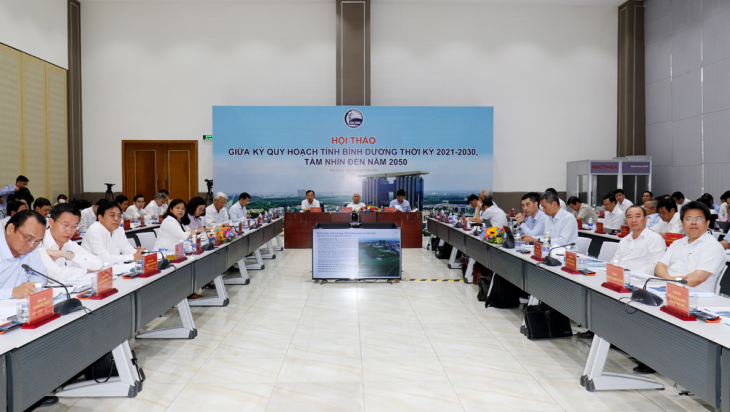
Overview of the Seminar
Regarding urban development, it is necessary to focus on planning, investment, embellishment and improvement of urban quality towards a smart, civilized, modern city, a place worth living, not to form a "slum" in the heart of the city. By 2025, it is necessary to remove the lanes and alleys with dirt roads, red gravel roads that have not been connected and the residents who have not met the infrastructure conditions, and fully meet the housing development targets (area of urban and rural housing, worker housing, social housing) according to the province's population scale forecast for each period.
The planning must solve the problem posed when the development models are transformed in the direction of applying science and technology, transforming production models to a generation of new industry, green industry, sustainable industry, and non-labor, land and energy intensive industry. Besides, it is necessary to transform 4.0 in enterprises, and improve technology chains. The State builds a digital government, a digital society, a digital economy, and strongly reforms administrative procedures. It is necessary to create a new ecosystem to attract high-quality human resources, and to plan a system of education and training institutions for development to meet high-quality human resources as required. Identifying specific solutions to mobilize the maximum resources from all economic sectors to carry out the tasks according to the planning, including investment in completing socio-economic and urban infrastructure, focusing on transport infrastructure connecting the region.
The Secretary requested, by the end of April 2023, to basically complete the final-term provincial planning project and collect opinions from the people to absorb and complete the planning. Along with identifying resources to organize the effective implementation of goals and tasks, consulting units and branches need to study and propose specific recommendations on institutions and policies for the Central Government to create resources and motivation for Binh Duong to develop in accordance with the approved planning.
Reported by Phuong Chi-Translated by Thanh Tam